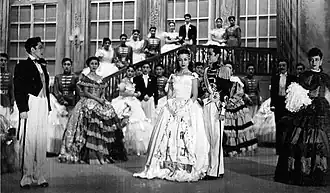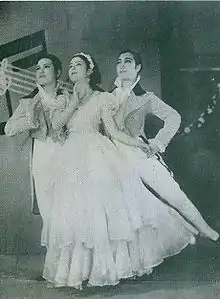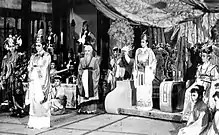Takarazuka Revue
The Takarazuka Revue (Japanese: 宝塚歌劇団, Hepburn: Takarazuka Kagekidan) is a Japanese all-female musical theatre troupe based in Takarazuka, Hyōgo Prefecture, Japan. Women play all roles in lavish, Broadway-style productions of Western-style musicals and stories adapted from films, novels, shōjo manga, and Japanese folktales. The Takarazuka Revue Company is a division of the Hankyu Railway company; all members of the troupe are employed by Hankyu.
宝塚歌劇団 | |
 Read western style, left-to-right, then top-to-bottom | |
 Parisette, 1930 | |
| Formation | 1913 |
|---|---|
| Type | Theatre group |
| Purpose | Musical theatre |
| Location |
|
| Website | kageki |
History
The Takarazuka Revue was founded by Ichizō Kobayashi, an industrialist-turned-politician and president of Hankyu Railways, in Takarazuka, Japan in 1913. The city was the terminus of a Hankyu line from Osaka and already a popular tourist destination because of its hot springs. Kobayashi believed that it was the ideal spot to open an attraction of some kind that would boost train ticket sales and draw more business to Takarazuka. Since Western song and dance shows were becoming more popular and Kobayashi considered the kabuki theater to be old and elitist,[1] he decided that an all-female theater group might be well received by the general public.

The Revue had its first performance in 1914. Ten years later, the company had become popular enough to obtain its own theater in Takarazuka, called the Dai Gekijō, meaning "Grand Theater".[2] Today, the company owns and operates another theater, the Takarazuka Theater, in Tokyo.[3] Currently Takarazuka performs for 2.5 million people each year and the majority of its fans are women.

Part of the novelty of Takarazuka is that all the parts are played by women, based on the original model of kabuki before 1629 when women were banned from the theater in Japan.[4] The women who play male parts are referred to as otokoyaku (男役, "male role") and those who play female parts are called musumeyaku (娘役, "girl role"). Collectively, the Takarazuka performers are called "Takarasiennes" (takarajiennu). This name derives from the revue's fondness of the French revues.[5]
The costumes, set designs and lighting are lavish, the performances melodramatic. Side pathways extend the already wide proscenium, accommodating elaborate processions and choreography.
Regardless of the era of the musical presented, period accuracy is relaxed for costumes during extravagant finales which include scores of glittering performers parading down an enormous stage-wide staircase and a Rockette-style kick line. Lead performers portraying both male and female roles appear in the finale wearing huge circular feathered back-pieces reminiscent of Las Vegas or Paris costuming.
Before becoming a member of the troupe, a young woman must train for two years in the Takarazuka Music School, one of the most competitive of its kind in the world. Each year, thousands from all over Japan audition. The 40 to 50 who are accepted are trained in music, dance, and acting, and are given seven-year contracts. The school is famous for its strict discipline and its custom of having first-year students clean the premises each morning.
The first year, all women train together before being divided by the faculty and the current troupe members into otokoyaku and musumeyaku at the end of the year. Those playing otokoyaku cut their hair short, take on a more masculine role in the classroom, and speak in the masculine form.
The company has five main troupes: Flower (花, hana), Moon (月, tsuki), Snow (雪, yuki), Star (星, hoshi), and Cosmos (宙, sora); as well as an emeritus troupe for senior actresses no longer part of a regular troupe who still wish to maintain their association with the revue and perform from time to time. Flower and Moon are the original troupes, founded in 1921. Snow Troupe was founded in 1924 and Star Troupe in 1931, disbanded in 1939, and reestablished in 1948. Cosmos, founded in 1998, is the newest troupe.
Actors

Though Takarazuka Revue gives the appearance of having been created to grant Japanese women freedom from social oppression, ironically, it was created with the opposite intention, with Takarazuka scholar Lorie Brau stating that "The production office and corporate structure that control Takarazuka are overwhelmingly patriarchal."[6] However, although Takarazuka embodies Shiraishi's idea that the actresses become "good wives and wise mothers" upon leaving the company, it also simultaneously represents progressive feminist points of view. Some believe that its appeal to the female audience is on account of the perceived link to freedom from traditional Japanese society's imposed ideas of gender and sexuality. Brau states that while the Takarazuka Revue "reinforces the status quo and sublimates women's desires through its dreamy narratives, there remains some possibility that certain spectators find it empowering simply to watch women play men."[6]
Some Takarasienne shows, such as The Rose of Versailles and Elisabeth, feature androgynous characters. In Brau's view, the otokoyaku represents the woman's idealized man, free from the roughness or need to dominate found in real life. It is these male roles that offer an escape from the strict, gender-bound real roles lauded in Japanese society.[6] In a sense, the otokoyaku provides the female audience with a "dream" of what they desire in reality.
In addition to their claim to "sell dreams", the actresses of the Takarazuka Revue take on another role, empowering themselves as women in a male-dominated culture. Kobayashi's desire to make his actresses into good wives and mothers has often been hindered by their own will to pursue careers in the entertainment business. It is becoming increasingly more common for women to stay in the company well into their thirties, beyond the perceived conventional limits of marriageable age. The actresses' role within the Takarazuka Revue thus overlaps into the culture surrounding it, adding to their appeal to the female-dominant audience. "In fact, it is the carrying over of this 'boyishness' into everyday life and the freedom that this implies that captures the attention of some fans."[6]
The otokoyaku, however, is not bound to her assigned male role in the theater. Tsurugi Miyuki, top otokoyaku star of the Moon Troupe, said that she conceived male impersonation as just a "role" that she wore like the makeup and costume that helped create her otokoyaku image. She said she reverts to her nonperforming "feminine" self after performance.[6] Other otokoyaku feel uncomfortable switching to female roles. Otokoyaku Matsu Akira, who retired in 1982, stated: "Even though I am a female, the thing called 'female' just won't emerge at all."[7]
Although traditionally an all-female troupe, in 1946 the Takarazuka employed male performers who were trained separately from the female members of the troupes. Ultimately, however, the female members opposed these new male counterparts, and the department was dissolved, the last male department terminating in 1954. A 2007 Japanese musical, Takarazuka Boys, was based on this chapter of the company's history.
While the casts are all-female, the staff (writers, directors, choreographers, designers, etc.) and orchestra musicians may be male or female. It is not uncommon in Takarazuka for a predominantly male orchestra to be led by a female conductor.
Troupes
The five troupes (組, kumi) of the Takarazuka Revue have certain differences of style and material which make each unique.
Flower Troupe (Hana-gumi)
The Flower Troupe is considered the "treasure chest" of otokoyaku. Many of the most popular former and current top stars of the company originated in Flower Troupe; these include Miki Maya (who held the first Budokan solo concert in Takarazuka's history), Sumire Haruno and Tomu Ranju of Flower, Jun Shibuki, Jun Sena and Kiriya Hiromu of Moon, and Hikaru Asami of Snow. Their performances tend to have larger budgets, with lavish stage and costume designs, and are often derived from operatic material.
Moon Troupe (Tsuki-gumi)
While tending to be a home for young performers (with Yūki Amami in her sixth year reaching the status of top star in the 1990s), the members of Moon Troupe are also strong singers. The term "Musical Research Department" is occasionally used in articles about the troupe, underscoring the troupe's focus on music. Their material tends toward drama, Western musicals, and modern settings, such as Guys and Dolls and Me and My Girl. During the era of Makoto Tsubasa as top star, they had at least two musicals adopted from classic western novels.
Snow Troupe (Yuki-gumi)
Snow Troupe is considered the upholder of traditional dance and opera for the whole company, being the vanguard of traditional Japanese drama in a company that tends towards Western material. They were the first troupe to perform Elisabeth in Japan. The troupe has been moving towards the opera and drama style of Moon and Flower.
Star Troupe (Hoshi-gumi)
Star Troupe tends to be the home of Takarazuka's stars. They, along with Flower Troupe, have very strong otokoyaku players. In recent years, many of the company's prominent musumeyaku have also originated from Star Troupe, such as Hana Hizuki, Shizuku Hazakura, and Yuki Aono.
Cosmos Troupe (Sora-gumi)
Cosmos, the newest troupe, is less traditional and more experimental. When it was first formed, it culled talent from the other troupes. The Cosmos style is influenced by performers like Asato Shizuki, the founding otokoyaku top star; Yōka Wao and Mari Hanafusa, the "Golden Combi" who headed the troupe for six of its first eight years. Cosmos were the first troupe to perform Phantom and to have a Broadway composer (Frank Wildhorn) write their musical score. Most of the otokoyaku in this troupe are above 170 centimetres (5.6 ft) tall (the most notable is Hiro Yuumi, the tallest in the company since she joined in 1997 until her retirement in 2013). While it had a troupe-born actress become musumeyaku top back in 2006 with Asuka Toono, it was not until 2014 that an actress originating from this troupe became an otokoyaku top star: Seina Sagiri, the former top star of Snow Troupe (2014–2017).
Types of musicals performed
Adaptations of Western works
While the majority of Takarazuka works are written "in house" by members of the creative staff, they are often adapted from Western classic musicals, operas, plays, novels or films:
Adaptations of Japanese works

Stories based in Japan and modeled on historical accounts or traditional tales, are often referred to as nihonmono (日本物) or, less frequently, wamono (和物). Among the most common of these adapted to the Takarazuka stage is The Tale of Genji.
Popular manga series have often shaped Takarazuka, such as in the case of Riyoko Ikeda's The Rose of Versailles. Other manga adaptations include The Window of Orpheus, also by Ikeda, Osamu Tezuka's Black Jack and Phoenix, and Yasuko Aoike's El Halcón.
Recent examples of works adapted from Japanese novels or short stories include Moon Troupe's Osaka Samurai (大阪侍), based upon the short story by Ryōtarō Shiba, and Flower Troupe's Black Lizard (黒蜥蜴, Kurotokage), based upon the Kogoro Akechi story by Edogawa Rampo.
In 2009, Takarazuka Revue performed two shows based on an adaptation of Capcom's video game series Ace Attorney.[12] They took the stage in January 2013 to represent the courtroom game again with the production titled Prosecutor Miles Edgeworth: Ace Attorney 3.[13] In June 2013, the Revue would debut at Tokyo's Tokyu Theatre Orb an adaptation of another Capcom video game, Sengoku Basara,[14] done by the Flower Troupe. This focused on character Yukimura Sanada, played by Tomu Ranju, the same actress who had taken the role of Phoenix Wright prior to becoming a top star.
In 2017, the Flower Troupe performed a stage adaptation of the shōjo (girls') manga series Haikara-San: Here Comes Miss Modern,[15] and performed it again in 2020.[16] In 2019, the Flower Troupe also performed a stage adaptation of the shōjo manga series Boys Over Flowers.[17] In August 2022, the Cosmos Troupe are set to perform a stage adaptation of the series High & Low[18] in collaboration with LDH.
Adaptations of other Asian works
Among works adapted from other Asian sources is the Beijing opera The Hegemon-King Bids His Concubine Farewell, detailing the romance between General Xiang Yu and his lover Madam Yu.
Original stories and historical adaptations
Musicals have also been performed throughout the years based upon people and events in American, European, and Asian history. Among the more recognizable of these biographical adaptations are Last Party: S. Fitzgerald's Last Day, about F. Scott Fitzgerald; Valentino, about Rudolph Valentino; Dean, about James Dean; and Saint-Exupéry: The Pilot Who Became "The Little Prince", about Antoine de Saint-Exupéry.
Finally, original stories round out Takarazuka fare, including musicals such as Boxman by Cosmos Troupe, Too Short a Time to Fall in Love performed by Star and Moon Troupes, and Silver Wolf by Moon and Snow Troupes.
Collaborations
Takarazuka has occasionally worked with notable writers, composers, and choreographers to create original content for the revue. In 1993, Tommy Tune wrote, directed and choreographed the revue Broadway Boys to accompany Moon Troupe's rendition of Grand Hotel. In 2006, Takarazuka worked with Frank Wildhorn, musical writer and composer of Jekyll & Hyde and The Scarlet Pimpernel, to create Never Say Goodbye for Cosmos Troupe. In 2019, Takarazuka worked with Dove Attia, music producer of 1789: Les Amants de la Bastille and La Légende du roi Arthur, to compose Casanova for Flower Troupe.
Personnel
Star personnel
The current top stars of each group are:[19]
| Group | Otokoyaku | Musumeyaku |
|---|---|---|
| Senka | Yū Todoroki[lower-alpha 1] | |
| Flower | Rei Yuzuka | Madoka Hoshikaze |
| Moon | Kanato Tsukishiro | Mitsuki Umino |
| Snow | Sakina Ayakaze | Aya Yumeshiro |
| Star | Makoto Rei | Hitomi Maisora |
| Cosmos | Toa Serika | Sakura Haruno |
- The youngest member to ever serve on the board of directors
Other main performers in the company
| Group | Flower | Moon | Snow | Star | Cosmos |
|---|---|---|---|---|---|
| Otokoyaku | Sea Towaki, Hikari Ayaki, Mahiro Hozumi, Asuka Seino | An Houzuki, Yuno Kazama, Haru Reika, Sera Ayami | Jun Asami, Sora Kazuki, Sen Agata | Yuria Seo, Chisei Akatsuki, Ema Amahana, Shin Kiwami | Minato Sakuragi, Hikaru Rukaze, Chiaki Takato |
| Musumeyaku | Ai Mihane, Misaki Hoshizora | Michiru Irodori, Juri Amashi, Riri Shirakawa, Haryuu Kiyora | Himari Nonoka, Yui Neiro | Kozakura Honoka, Yuri Mizuno, Hanaka Ruri, Chizuru Uta | Mineri Amairo, Sara Hanamiya, Hibari Yamabuki |
Seniority
The gender-neutral terms senpai (upperclassmen) and kōhai (lowerclassmen) are used to distinguish senior and junior members of Takarazuka. Lowerclassmen are the actresses who have been performers in Takarazuka for less than seven years. They are employees of the company, and usually work as background dancers and in shinjin kōen (performances exclusively for underclassmen). After the seventh year they become upperclassmen, and negotiate contracts with the company instead of being employed by it.
Former Takarasiennes
Takarazuka roster members who went on to work in stage, movies, and television include:
| Otokoyaku | Musumeyaku |
|---|---|
|
Audience
Women make up the primary audience of Takarazuka; in fact, some estimates say the audience is 90 percent female.[6] There exist two primary theories as to what draws these women to Takarazuka. These theories, put forward by Western scholars, complement each other, drawing on the traditional homoerotic elements of Japanese performing arts, and the ancient subversive nature of the feminine in Japan. One is that the women are drawn to its inherent lesbian overtones. One author states, "It was not masculine sexuality which attracted the Japanese girl audience but it was feminine eroticism".[20] Another theory is that the girls are not drawn to the implicit sexuality of Takarazuka, but instead are fascinated by the otokoyaku (the women who play male roles) "getting away with a male performance of power and freedom".[21]
Favoring the first theory, American Jennifer Robertson[22] observes that lesbian themes occur in every Takarazuka performance, simply by virtue of the fact that women play every role. The audience clearly picks up on it and responds. Within the first ten years of Takarazuka's founding, the audience was vocally responding to the apparent lesbianism. Female fans wrote love letters to the otokoyaku. In 1921 these letters were published and several years later newspapers and the public rallied a cry against Takarazuka, claiming it was quickly becoming a "symbol of abnormal love". In order to combat this, the producers kept its actresses in strict living conditions; they were no longer allowed to associate with their fans.[23] Robertson mentions a phenomenon of "S" or "Class S" love, a particular style of love wherein women who have been influenced by Takarazuka return to their daily lives feeling free to develop crushes on their female classmates or coworkers. This type of romance is typically fleeting and is seen in Japanese society as more of a phase in growing up rather than "true" homosexuality.[20] Robertson sums up her theory thus: "Many [women] are attracted to the Takarazuka otokoyaku because she represents an exemplary female who can negotiate successfully both genders and their attendant roles and domains."[23]
The other theory, supported by Canadian Erica Abbitt,[24] is that the female audience of Takarazuka is drawn not exclusively by lesbian overtones, but rather by the subversion of stereotypical gender roles. Japan is a society notorious for its rigid conception of gender roles. While the original goal of the show may have been to create the ideal good wife and wise mother off stage, on-stage gender roles are, by necessity, subverted. The otokoyaku must act the way men are supposed to act. Abbitt insists that a large portion of the appeal of Takarazuka comes from something she calls "slippage", referring to the enjoyment derived from a character portraying something they are not, in this case a woman portraying a man. While not denying the presence of lesbian overtones within Takarazuka, Abbitt proposes the cause for the largely female audience has more to do with this subversion of societal norms than sexual ones.[21] In essence, the role of otokoyaku presents a type of androgynous freedom that embraces slippage and a non-constrained continuum of gender.[25] While the actual female otokoyaku performer's masculine persona or "secondary gender" was disapproved of outside of the theatrical purposes of Takarazuka, female fans were able to embrace the full gender-fluid continuum otokoyaku provided, as well as engage with Takarazuka in the context of a gender-sex political discourse.[5]
Fan clubs

Some fans demonstrate their loyalty to a particular performer by joining her fan club. Club members can be identified by their wearing scarves of a particular color or even jackets colorfully embroidered with the star's name. Following performances at the Takarazuka Grand Theatre or Tokyo Takarazuka Theatre, as many as several hundred fans congregate in their various club groups and stand in orderly ranks on either side of the street in front of the theatre. The clubs are arranged by actress seniority within the troupe. Theatre officials set up barricades and oversee the assembly.
Whenever an actress exits the theatre, the frontmost group will sit and all the others follow suit (much like the "wave" seen in athletic arenas) with subsequent intervals of standing and sitting. The fans wait patiently, with little conversation, for their favorites to exit the theatre.[26] An almost eerie ritualistic calm prevails. As the stars come out of the building one by one, some alone but most accompanied by staff members of their club, orderly quiet continues to prevail. The glamorous performers, now mostly in slacks or jeans with high heels and wearing oversize visored "newsboy" caps to hide their hair (and some with sunglasses even at night), move along to their own particular fan clubs. Rather than requesting autographs, the fans proffer cards, which are gathered efficiently by each star, who may say a few words but then waves and moves on. Once the last stars have emerged and departed, the clubs disband quietly.
Influence
Takarazuka has had a profound influence on the history of anime and manga, especially shōjo manga.[27][28] Osamu Tezuka, a highly influential manga creator, grew up in the town of Takarazuka. His mother knew many of the Takarazuka actresses, and as a child he knew them and watched many of their performances.[27][29] Based on their stories of noble princes played by female actresses,[27] Tezuka created Princess Knight,[30] the first manga aimed at a female audience, which tells the story of Princess Sapphire, a girl born with both a male and female heart who struggles between the desire to fight as a noble prince and to be a tender, gentle princess. The great success of Princess Knight and other Tezuka stories began the tradition of manga written for a female audience, especially the very influential The Rose of Versailles and Revolutionary Girl Utena series, both of which borrow directly from Princess Knight by including specific Tezuka images, character designs and names. The Rose of Versailles is one of Takarazuka's best-known musicals. Women in masculine roles continue to be a central theme in shōjo manga and anime, as well as in some shōnen (boys') series, and Tezuka himself explored the theme in many of his later works, including Dororo, Phoenix and Black Jack.
While the influence of Osamu Tezuka and Takarazuka on anime and manga is general, there are still many series which show more specific influences. The Takarazuka Revue inspired the plot of the original Sakura Wars video game, along with additional inspiration from Takarazuka's one-time competitor the Shochiku Kagekidan (Shochiku Revue).[31]
The Zuka Club in Ouran High School Host Club is based on the Takarazuka Revue.
The lesbian characters Haruka Tenou and Michiru Kaiou of Sailor Moon were loosely based on the actors of the Takarazuka Revue.[32]
The Virgin's Mask by Jūrō Kara, a significant work of post-war theater, features an aging "Zuka-girl" attempting to reclaim her youth through ritualistic bathing in a tub of virgins' tears.
The musical anime series Revue Starlight has elements based on the troupe, including uniforms, the school seal, and theater style, and makes use of these elements to present a critique of Takarazuka practices, particularly the Top Star system.[33]
The Tokyo theater group Kegawa Zoku ("Fur Tribe") has produced homosexual parodies of classic Takarazuka shows like Gone with the Wind.[34]
The manga and anime series Kageki Shojo!! follows two teenage girls enrolled in a fictional version of the Takarazuka Music School. There, they train in singing, acting, and dancing, in hopes of joining the infamous all-female theatre troupe. One of the girls, Sarasa, dreams of playing Oscar François de Jarjayes in the theatre's production of Rose of Versailles.[35]
The one episode of the anime series Stop!! Hibari-kun! features Wataru Otori, an eccentric drag king who takes on the role of Rhett Butler for the Gone with the Wind play.
Takarazuka and homosexuality in Japanese society
After the scandal of women writing love letters to the otokoyaku and the revelation of an actual lesbian relationship between a otokoyaku and a musumeyaku, the revue greatly limited itself in order to do away with the lesbian image. Women wore militaristic uniforms, heightening the attraction even more among some audience goers. There was another scandal in 1932 when, for the first time, one of the otokoyaku cut her hair short (previously all of the actresses had their hair long and the otokoyaku simply hid their hair under hats).[36] In August 1940, the actresses were even forbidden to answer fan mail and socialize with their admirers.[23] In the years since then, the regulations have relaxed but not by much.
Legacy
In the 1957 film Sayonara, set largely in neighboring Kobe, the all-female "Matsubayashi" theater troupe bears many similarities to the Takarazuka Revue.
A 1996 black-and-white photograph of a Takarasienne, taken by Daido Moriyama, appeared on the October 1999 cover of Art in America.[37]
See also
- Films from Takarazuka Revue produced by Takarazuka Eiga
- Breeches role
- Cross-dressing
- Drag (clothing)
References
- Kobayashi Ichizo. "Takarazuka Manpitsu (1955)". Tokyo, Daiyamondsha. 1961. Kobayashi Ichizo 2: 445-46.
- Kawatake, Toshio. "A History of Japanese Theater II: Bunraku and Kabuki". Kokusai Bunka Shinkokai. Tokyo. 1971. pp. 15–52.
- Takahara, Kanako, "Fans make troupe phenomenon it is", The Japan Times, 23 June 2009, p. 3.
- Leupp, Gary P. Male Colors: The Construction of Homosexuality in Tokugawa Japan. University of California Press, 1997. ISBN 0-520-20900-1.
- Robertson, Jennifer (August 1992). "the politics of androgyny in Japan: sexuality and subversion in the theater and beyond". American Ethnologist. 19 (3): 419–442. doi:10.1525/ae.1992.19.3.02a00010. hdl:2027.42/136411.
- Lorie Brau. ""The Women's Theatre of Takarazuka." TDR 34.4 :79-95.
- Robertson, Jennifer (1989). "Gender-Bending in Paradise: Doing 'Female' and 'Male' in Japan". Genders. 5: 50–69. ISSN 0894-9832.
- 木原敏江「アンジェリク」新装版が「星降草子」と同時発売 [New edition of Toshie Kihara's Angélique released at the same time as Hoshifuru Sōshi]. Comic Natalie (in Japanese). 16 May 2014. Retrieved 17 February 2021.
- 木原 敏江 [Toshie Kihara]. Mangapedia (in Japanese). Heibonsha, Shogakukan, et al. Retrieved 17 February 2021.
- The Takarazuka Concise Madame Butterfly, tr. by K. and L. Selden, introduced by Arthur Groos in Japan Focus 14, 14, 7 (July 2016).
- ミュージカル『アーサー王伝説』 [Musical: Legend of King Arthur]. Official Takarazuka Revue (in Japanese). Retrieved 6 April 2017.
- 株式会社カプコン:ゲーム:逆転裁判シリーズ:タイトルラインナップ. Capcom.co.jp. Retrieved 9 March 2015.
- "Takarazuka Revue Will Present Third Show in the Ace Attorney Series". Capcom.co.jp. Retrieved 9 March 2015.
- "Capcom and Takarazuka Revue Will Present the First Musical Based on the Sengoku BASARA Series - First production by the Takarazuka Flower Troupe based on a game is expected to further raise the value of Capcom content". Capcom.co.jp. Retrieved 9 March 2015.
- Hodgkins, Crystalyn (14 April 2017). "Haikara-san ga Tōru Manga Gets Musical by Takarazuka Revue". Anime News Network. Retrieved 17 February 2021.
- ミュージカル「はいからさんが通る」再演決定、花組新トップ柚香&華のお披露目公演. Comic Natalie (in Japanese). 29 July 2019. Retrieved 17 February 2021.
- Hodgkins, Crystalyn (11 January 2019). "Boys Over Flowers Manga Gets Musical by Takarazuka Revue's Flower Troupe". Anime News Network. Retrieved 17 February 2021.
- HiGH&LOW×宝塚歌劇!SWORD誕生前夜のコブラの悲恋描く宙組公演. Music Natalie (in Japanese). 24 December 2021. Retrieved 28 February 2022.
- "About Us". Takarazuka Revue - Official Website.
- Dollase, Hiromi (2003). "Early Twentieth Century Japanese Girls' Magazine Stories: Examining Shōjo Voice in Hanamonogatari (Flower Tales)". The Journal of Popular Culture. 36 (4): 724–755. doi:10.1111/1540-5931.00043. OCLC 1754751.
- Abbitt, Erica Stevens. "Androgyny and Otherness: Exploring the West Through the Japanese Performative Body". Asian Theatre Journal 18.2: 249-256.
- "Jennifer Robertson". umich.edu. Retrieved 9 March 2015.
- Robertson, Jennifer. "Takarazuka: Sexual Politics and Popular Culture in Modern Japan." Berkeley: University of California Press, 1998.
- "Prof. Erica Abbitt's webpage at the University of Windsor, Canada". uwindsor.ca. Retrieved 9 March 2015.
- Abbitt, Erica Stevens (2001). "Androgyny and Otherness: Exploring the West Through the Japanese Performative Body". Asian Theatre Journal. 18 (2): 249–256. doi:10.1353/atj.2001.0012. ISSN 1527-2109. S2CID 162239691.
- "The feminine 'kabuki' alternative". taipeitimes.com. 11 June 2006. Retrieved 9 March 2015.
- Randall, Bill (15 May 2003). "Three By Moto Hagio". The Comics Journal (252). Retrieved 23 January 2008.
- Anan, Nobuko (2016). Contemporary Japanese Women's Theatre and Visual Arts. London: Palgrave Macmillan UK. doi:10.1057/9781137372987. ISBN 9781349557066.
- Gravett, Paul (2004). Manga: 60 Years of Japanese Comics. Harper Design. p. 77. ISBN 1-85669-391-0.
- Welker, James (2006). "Beautiful, Borrowed, and Bent: 'Boys' Love' as Girls' Love in Shōjo Manga". Signs: Journal of Women in Culture and Society. 31 (3): 841. doi:10.1086/498987. S2CID 144888475.
- Interview with Ouji Hiroi, partially translated at the Takarazuka Revue Community LiveJournal page Archived 5 February 2008 at the Wayback Machine. With regards to Sakura Wars, not only did the Kagekidan inspire the plot for the series, it also strongly influenced the organization of the characters, namely the Hanagumi. Retrieved on 19 July 2007
- Takeuchi, Naoko (October 1, 1999). Materials Collection. Translated by Alex Glover. Japan: Kodansha. Retrieved 10 October 2006.
[Haruka] plays a male role in Takarazuka.
- "Series Finale: Revue Starlight ‒ Episode 12". Anime News Network. Retrieved 31 March 2019.
- Anan, Nobuko (2011). "Two-Dimensional Imagination in Contemporary Japanese Women's Performance" (PDF). TDR/The Drama Review. 55 (4): 96–112. doi:10.1162/DRAM_a_00125. ISSN 1054-2043. S2CID 55532655.
- Moore, Caitlin (24 November 2020). "Review: Kageki Shoujo!! The Curtain Rises". Anime News Network. Retrieved 18 February 2021.
- Robertson 1998, p. 13.
- "Cover entitled Osaka". Art in America. Vol. 87, no. 10. October 1999 – via Amazon.
General references
- Robertson, Jennifer Ellen (1998). Takarazuka: Sexual Politics and Popular Culture in Modern Japan. Berkeley and Los Angeles, Calif.: University of California Press. p. 50. ISBN 0-520-21150-2.
- The Politics of Androgyny in Japan: Sexuality and Subversion in the Theater and Beyond Jennifer Robertson American Ethnologist, Vol. 19, No. 3 (Aug., 1992), pp. 419-442.
Further reading
- Leonie R. Stickland, Gender Gymnastics: Performing and Consuming Japan's Takarazuka Revue, Melbourne, Australia: Trans Pacific Press, 2008 Review of Gender Gymnastics
- Makiko Yamanashi, A History of the Takarazuka Revue Since 1914. Modernity, Girls' Culture, Japan Pop, Leiden: Global Oriental & Brill, 2012 Review of A History of the Takarazuka
- James Roberson and Nobue Suzuki, Men and Masculinities in Contemporary Japan: Beyond the Salaryman Doxa, London and New York: Routledge Curzon, 2003
- Alisa Roost. "Elisabeth". Theatre Journal. Vol 60.2.
- "Japanese tradition meets Western musicals"—Article on the Takarazuka Revue from the travel section of The Christian Science Monitor (20 April 2005).
- "Welcome to Romance Theatre", by K. Avila, Jade Magazine, March 2004.
- Anan, Nobuko (2016). Contemporary Japanese Women’s Theatre and Visual Arts. London: Palgrave Macmillan UK.
- "A Century of Dreams and Romance: A History of Japan's All-Female Takarazuka Revue". Nippon.com. 4 June 2014. Retrieved 17 February 2021.
- "A History of Takarazuka Revue Influences in Anime". Anime News Network. 15 September 2021. Retrieved 15 September 2021.
External links
- Official website: Japanese version, English version
- The Takarazuka Revue—A 1996 article originally published in Polare magazine
- The Takarazuka Concise Madame Butterfly, tr. by K. and L. Selden, introduced by A. Groos in Japan Focus 14, 14, 7 (July 2016)

